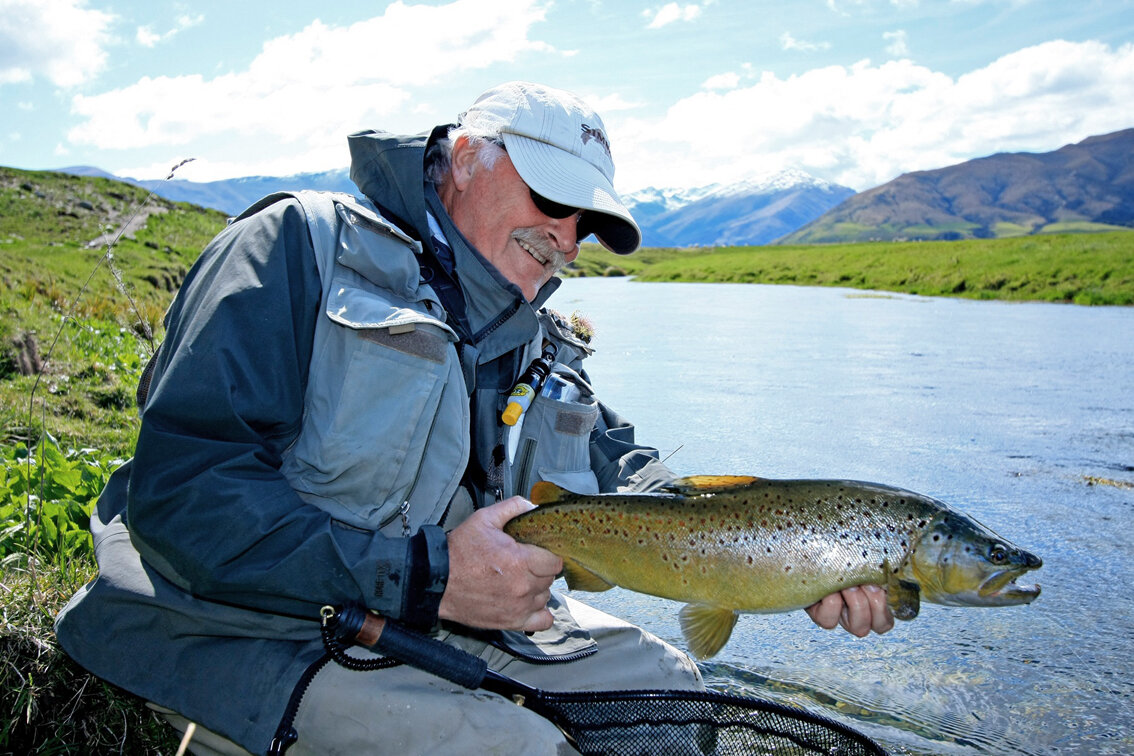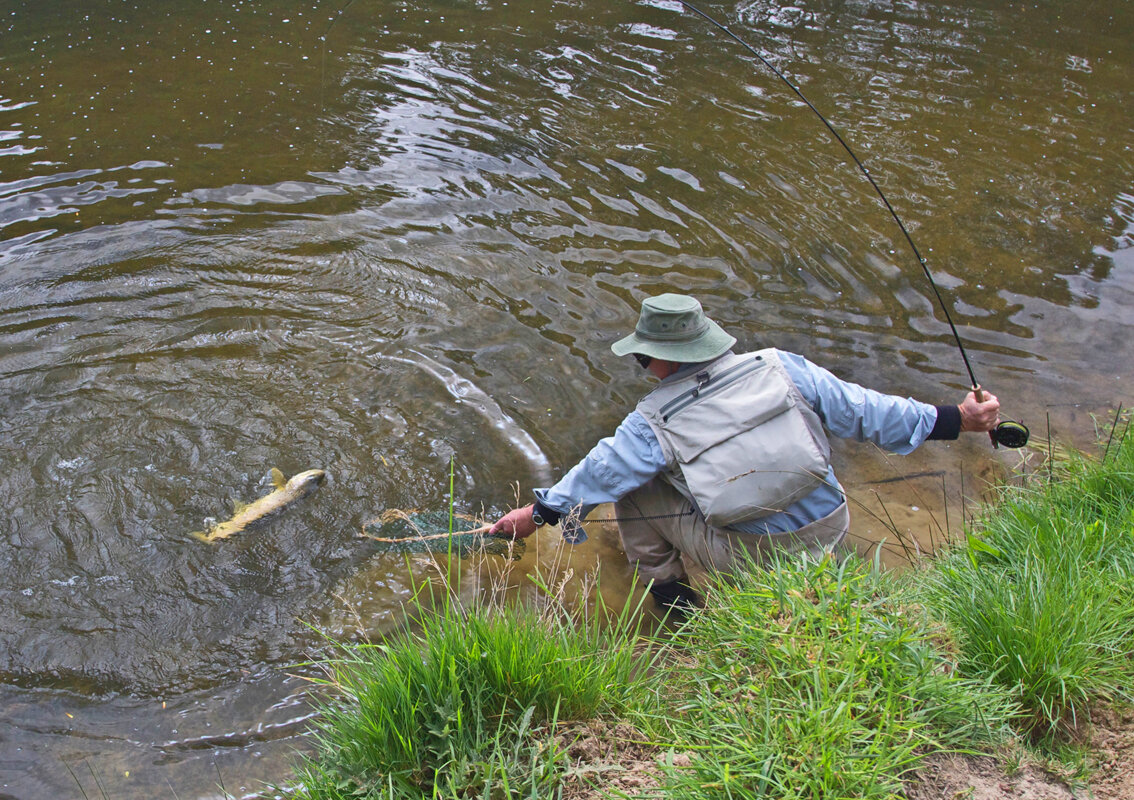
Bob Wyatt
.
Bob Wyatt
1. Choice of equipment Rods, reels, fly lines, fly floatants, clothes, glasses and other useful items.
I prefer rod actions that are not too stiff, but quick, medium fast, which permit easy rolls and single hand Spey casts, as well as nice tight loops when I have to drill one under an over hanging tree or into a headwind.
For trout, I use a couple of the superb Epic rods produced by Swift Fly Fishing in New Zealand, a 590-C and a 690-C. These cover everything I do, from loch style on the northern Scottish lochs for half pound brownies, to sea trout, big water and throwing large flies in a wind. There's really not a big difference between them, but the 690 lets me go up a line size when I need to.
My reels are all pretty old school. Not click and pawl old school, but cork drag Abels and Tibors. I especially like the old deep arbor Big Game series, and a few of the Super Series in a range of sizes. Rugged, smooth, a bit heavy for current tastes – you could drive nails with them - but you really can't beat 'em. I also have a few of the great Swedish Danielsson large arbors, in size 5/8 - strong, lightweight reels that never let me down.
Lines are either Scientific Anglers (Epic) or Rio, mostly floaters with a longish belly for distance and roll/spey casts. Most trout fishing is at fairly close quarters, so the long bellies cover it and permit the occasional long throw without false casting. I do like a aggressive front taper, which is great for turnover on windy days, and I just stop high on the forward throw for more delicate presentations.
Good polarised shades, I like the Serengetis, are essential. Otherwise just good quality gear all round. The extra cost is always worth it, and it lasts.
2. Leader material, build up, length and knots.
I prefer heavy butt, tapered nylon leaders of twelve feet, and 7-8 lb test for trout. I usually cut it back a bit to add a tippet of 6-4 lb test Stroft or Rio copolymer. I almost never go below 6lb test for trout, except for maybe a spinner fall on glassy water.
3. Approach and stealth.
Apart from finding fish and casting, this is job one. Nothing else is more important than where and how you move. Trout are highly sensitive to unfamiliar movement, and no amount of fly changing will make up for it. Its easy to step on a big brownie lying in inches of water at the tail of a pool as you make your way to the attractive "fishy" water at the head. Be extra careful entering a pool tail from below. Big fish often lie right at the cusp of the pool in inches of water. That big bow wave is the sign that you’ve spooked him. Go slow and stay low.
False casting is probably the newbie’s prime fault. It’s a dead certain fish spooker and there are ways to get a line out there without all the overhead stuff. Get up close and make one good shot. Own a good roll cast. The water haul is important.
4. Reading the water.
Knowing where fish hold for either safety or feeding is essential and comes with experience. Knowing when you have spooked an unseen fish is really just as important as catching a seen one. Understanding the way a current affects your drift and drag comes with experience. Don’t rush at it. Standing still and watching will always pay off better than just charging ahead and casting.
5. Casting ability which casts are essential.
Casting is at the heart of fly fishing. It will make or break your day. It still surprises me how many anglers just haven't learned to cast, or have just an overhead throw in their repertoire, and often a poor one. Rolls, speys, casting in several planes, the reach cast - all are not just useful but essential. Practice. More practice.
6. Entomology, what should we know.
Knowing your bugs and what fish eat is interesting and obviously important. "matching the hatch" can, in my opinion, be taken too far and can induce “fly anxiety”, which is almost impossible to cure once you catch it.
Stealth, casting and presentation skills far outweigh fly selection. Trout aren't as discriminating as we are led to believe, and are definitely not 'suspicious'. They can be, on the other hand, spooky. Opinions differ on this, but I’m right. Knowing when and what kind of hatches are due at different times of the season is essential, not just for fly selection but knowing what the trout will be doing.
7. Rise forms Can they tell us something?
Rise forms will tell us if the fish is taking food from the top, or just under the surface, or if they are chasing baitfish or, say, flying damselflies, but apart from that it's not a real science.
8. Fly selection, Size, shape, materials, which flies are essential.
My mantra is GISS - General Impression, Shape and Size. Get these elements in the ballpark and you're good to go. Fly posture, movement and behavior is important. Pattern is not as important as fly design. My go-to designs are the DHS (Deer Hair Sedge) and the DHE (Deer Hair Emerger), with its sister, the SHE (Snowshoe Hare Emerger) and the Dirty Duster. In a range of sizes and tied both skinny and chunky, these flies serve in most dry fly situations, in any hatch, including the most difficult, the spinner fall. I prefer Snowshoe hare foot fur, if you can get the real stuff, to CDC, which slimes up quickly and too often becomes a one-fish fly in the middle of a short rise. There are differing opinions on this, too.
My flies normally have hare’s mask and /or seal’s fur bodies that soak up water and penetrate the surface. I use a good paste floatant to keep things in the surface film. A body which penetrates the surface is very important in my view. It permits the trout to notice the fly at a distance and lock onto it early. I normally do without tails and other appendages, except for rubber legs on big dry stonefly or hopper patterns. Anything above the surface is decoration.
9. 10. Presentation and drifts / Upstream or downstream?
Casting, line control, and awareness of shadows, leader flash, etc, will make or break your day. Approaching from downstream, across, or upstream is basic, and knowing how to present a fly from any position requires experience and skill. You learn from your mistakes. The trout will always see your leader or tippet, so I try to avoid it crossing the fish’s line of vision if possible. Before you change flies, change the angle. Control drag. Practice, but preferably not on real trout, especially big ones.
11. Fighting fish.
Don't use too light a tippet. Keep the pressure on, keep your rod tip low and your drag set light, let 'em run, get 'em in quick, keep 'em wet.











